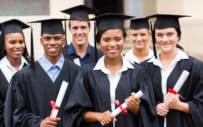
In positive news for the Class of 2026, nearly 87% of employers responding to NACE’s Job Outlook 2025 Spring Update survey said their organization will be actively recruiting for both full-time and internship positions in fall of 2025.

In spring 2025, NACE conducted a follow-up poll to a 2023 survey to better understand the current mental health concerns of NACE members. In the latest poll, more than half of participants self-reported that their mental health was worse at the time of the poll than it was last year at the same time.

There has been much discussion about whether a degree is necessary for every job. The answer is “no.” About half of employers responding to NACE’s Job Outlook 2025 Spring Update survey said their organization has positions that are flexible in terms of degree.

Almost two-thirds of employers responding to NACE’s Job Outlook 2025 Spring Update survey reported using skills-based hiring to help them identify candidates with potential.

NACE surveyed early career professionals about their experiences and attitudes; in this article, we examine the effects of gender on the experiences of early career talent.

Hybrid and in-person remain the preferred work modalities of employers for both their overall and entry-level positions, which matches the ways students prefer to work, NACE research has found.

Although overall hiring projections are up just 0.6% from last year, nearly 90% of employers anticipate increasing or maintaining hiring for the college Class of 2025, according to NACE’s Job Outlook 2025 Spring Update.

NACE surveyed early career talent—those who graduated in 2021, 2022, and 2023—to determine if (and how) experiential learning impacted their careers once they had graduated and landed in their first job. The results showed that those who took part in experiential learning while in college had higher rates of career satisfaction and a higher average salary than those who did not engage in experiential learning.

More than 70% of organizations expect to increase or maintain intern hiring, according to NACE’s 2025 Internship & Co-op Report. However, overall intern hiring is expected to fall 3.1%.

The average hourly wage for bachelor’s degree level interns has increased each year over the past 10 years and now stands at $23.04, according to NACE’s 2025 Guide to Compensation for Interns & Co-ops.

Career center budgets for the 2024-25 academic year have increased across the board since 2022-23, according to results of NACE’s 2024-25 Career Services Benchmarks survey.

Understanding the experiences, preferences, and goals of the early career Gen Z professional will help employers craft meaningful experiences that will ultimately enhance productivity and retention, while career centers will be able to better guide their students.

Attendance numbers reflect the preferences employers and students have for the format of career fairs, results of NACE’s 2024-25 Career Services Benchmarks survey reveal.

More than 200 senior career services leaders took part in a March 5 virtual meet up hosted by NACE to discuss effects of the Trump administration’s recent executive orders and “Dear Colleague” letter on the profession.

Designed to help NACE members with strategic planning and positioning, the 2025 environmental scan provides a current view of the landscape as it relates to career development and the early career talent recruiting space. The scan includes current demographic data as well as projected data and special survey data of the past year.

The Lilly Ledbetter Fair Pay Act of 2009 and pay transparency laws enacted by a number of states are helping to advance equal pay for equal or similar work.

There is a clear and persistent disconnect between how students and employers perceive students’ development of the competencies they need to be career ready as they enter the workforce.

College students from the Class of 2025 looking to enter the job market should highlight on their resumes the attributes and skills they developed in their classwork and through their various experiential assignments. But which attributes and skills are most important to employers?

Close to two-thirds of employers responding to the Job Outlook 2025 survey reported that they use skills-based hiring practices for new entry-level hires, and more than half use these practices always or most of the time in their hiring process.

Hiring for the college Class of 2025 is expected to increase 7.3% over hiring for the Class of 2024, according to NACE’s Job Outlook 2025 survey.

Nearly 85% of Class of 2023 bachelor’s degree graduates and nearly 90% of master’s degree graduates were employed or engaged in further education within six months of graduation.

While some of the experiences of nontraditional-aged students mirror those of their traditional-aged peers, there are important areas where they diverge. This information can help career service professionals and recruiters better serve this growing group of college students.

Because faculty are frequently asked by their current and former students for career advice, there is an opportunity to increase awareness among faculty of the resources available to them.

There are interesting data points from NACE’s 2024 Recruiting Compensation Report in terms of budgets, internship offers, and retention that provide insight into the operations and approaches of URR functions.

Recruiters are taking more time to extend an offer to a candidate following an interview, but the deadline for acceptance remains close to two weeks.

The political and social unrest seen on college campuses last spring and that may potentially reignite this fall has little impact on college recruiting, according to results of a recent NACE quick poll.

Lifted by average increases that ranged between 3.5% and 4.4%, salaries for all recruiting professionals increased in 2023, while the majority of respondents at all levels received bonuses.

NACE is conducting a quick poll and would like your input to assess ways that campus recruiting may be impacted. Last spring, we saw increased campus protests and lockdowns in response to student activism. As we prepare for the fall semester and campus recruiting, there is a potential for increased campus unrest in response to global and national events (i.e. Presidential election, war in Middle East). This Quick Poll is intended to get an overall understanding of the ways university recruiters and campus career centers are preparing for possible campus unrest related to the recruiting process.

The conversion rate for interns fell, fueled by a lower offer rate. The lower rate could reflect lower-than-expected hiring needs or could signal an issue with the intern selection process.

The college Class of 2024 is looking for economic security in a job, according to results of NACE’s annual student survey.

While nearly 20% of employers that responded to NACE’s Job Outlook 2024 Spring Update survey have had discussions about removing the college degree as a key requirement for entry-level positions, nearly 80% of respondents expect that there will be no change in the next two years.

Despite the Supreme Court’s 2023 ruling overturning affirmative action, the decision appears to be having little to no impact on employers’ DEI recruiting priorities.

Results of a NACE quick poll identify barriers and accelerators affecting the career paths of career services and university recruiting professionals.

Hiring for internships is expected to remain stable this year, according to NACE’s 2024 Internship and Co-op Report. Overall, eight out of 10 employers taking part in NACE’s annual benchmark report expect to maintain (47.2%) or increase (32.2%) the number of interns they bring in for 2023-24 compared to the 2022-23 academic year.

Nearly 83% of employers responding to NACE’s Job Outlook 2024 Spring Update survey anticipate increasing or maintaining hiring for the Class of 2024. This leaves just 17.4% of respondents planning to decrease hires, but their planned cuts mean overall hiring projections are down 5.8% from last year.

Belonging at work—feeling that one is valued, accepted, and supported—helps to ensure a healthy, productive, and positive work environment. NACE surveyed its membership to better understand their experiences with belonging in the profession.

Hourly wages for interns have kept pace with inflation, signaling the value of these programs to employers.

When it comes to the attributes of a job and an organization and the benefits the organization offers, there are some differences in student preferences by race and gender.

Women remain underrepresented in computer science majors and careers. Two researchers conducted a study to see how women in computing experience and make sense of their internships, and how their internship experiences shape their future career plans.

A study found that mentorship, community, biculturalism, and resilience are crucial resources and skills that Black women can use to advance their careers.

Recent studies reveal that systemic barriers continue to limit progress on achieving pay equity for all, but there are tangible, proven ways that career centers and employers can make an impact.

Despite calls to “return to the office” from employers and the prevailing media narrative, the hybrid work modality appears here to stay.

NACE’s Job Outlook 2024 survey found that among employers that capture their new hires’ degree modality, 87.4% hired new college graduates with an online degree.

Although new college graduates looking to enter the workforce and employers hiring these graduates agree on which competencies are most important for job candidates to hone, their perception of student proficiency in them differs.

Career services practitioners can help college students attract the attention of employers via their resume by encouraging them to highlight the skills they developed through their education and experiences.

After two relatively down years connected with the COVID-19 pandemic, the outcomes rate for Class of 2022 bachelor’s degree graduates returned to pre-pandemic levels.

In this op ed piece, Chris Miciek discusses problems with jumping into AI without considering the consequences and urges we take the middle ground.

NACE President & CEO Shawn VanDerziel shares NACE research, which indicates that both employers and college students and graduates view higher education and the college degree as valuable.

Slightly more than 43% of employers plan to increase starting salaries to Class of 2024 bachelor’s degree graduates, and nearly all remaining employers anticipate keeping salaries at last year’s levels.

New college graduates embrace the value of higher education, with 91% reporting that, if they had a chance to do it again, they would opt to pursue a college education.

The small dip in college hiring revealed by NACE’s Job Outlook 2024 survey is down from the last two years, when the college job market experienced brisk growth that, in 2022, reached record levels.

Employers confirmed their belief in the value of higher education and higher education institutions in NACE’s latest benchmark survey.

The National Association of Colleges and Employers (NACE) polled its career services members in spring 2023 about their use of AI in their work and in their work with students.

As we enter the new school and recruiting season, NACE is conducting a Fall Quick Poll. The focus of our poll is on two important issues– the impact the end of Affirmative Action is having on our work and state of unpaid internships.

The research suggests that, long term, we will likely work in and out of the office. Research from the National Association of Colleges and Employers shows that new college graduates want to be in person at least part of the time, but also want the flexibility to work remotely some of the time.

Early data from a forthcoming NACE study indicate that the gender pay gap has widened over the past year, with female graduates now earning just 72 cents to every dollar earned by male graduates, down from around 81 cents.

Projections in the Job Outlook 2023 Spring Update show that employers are planning to hire 3.9% more graduates from the Class of 2023 than they did from the Class of 2022.

A study at a minority-serving institution uncovers aspects of social and cultural capital that contribute to the college-to-career transition of Black undergraduate women.

NACE has conducted research that identifies important trends and unearths key insights that can help members enhance or adjust their operations to meet challenges and demands.

Slightly more than 85% of employers reported having formal diversity recruiting goals, according to NACE’s 2022 Recruiting Benchmarks Report, but how effective are these efforts?

The amount of time for students participating in a job interview to receiving an offer has increased over the past several years, but the time they take to accept the offer dropped in 2022.

Career services practitioners can help college students attract the attention of employers via their resume by encouraging them to highlight the skills they developed—such as problem-solving and teamwork skills—through their various experiences, according to NACE’s Job Outlook 2023 report.

Employers plan to hire 14.7% more new college graduates from the Class of 2023 than they did from the Class of 2022, according to NACE’s Job Outlook 2023 report.

Employers are strongly committed to in-person college recruiting activities this fall as they are largely unencumbered by travel restrictions that organizations imposed during the COVID-19 pandemic, according to results of NACE’s Quick Poll on Fall Recruiting and Career Services.

Based on their forward-looking staffing plans for the upcoming year, it appears employers are expecting similar or higher levels of recruiting activity this year, according to preliminary results of NACE’s Summer 2022 Quick Poll on Fall Recruiting and Career Services.

The percent of interviews resulting in a job offer has climbed to its highest level of the past five years, but acceptances and retention rates for the first three years of employment fell.

To facilitate planning and benchmarking for both employers and career centers, the National Association of Colleges and Employers (NACE) is conducting a quick poll that looks at fall recruiting as well as how career services offerings will be delivered.

Employers overwhelmingly believe hosting internships is the recruiting strategy that yields the highest return on investment leading to entry-level hires.

There were gender and race disparities within the compositions of the 2020-21 intern cohort as the majority of students who take part in internships are men and identify as white, according to results of NACE’s 2022 Internship & Co-op Survey.

More than 80% of schools conducted first-destination surveys in 2021-22, according to NACE’s 2021-22 Career Services Benchmarks Survey Report.

Economic uncertainty often causes employers to amend their expectations of new hires. The 2008 economic recession and the unexpected events of COVID-19 are two examples where mindsets around recruiting shifted, and the entry-level employment landscape yielded unexpected results.

The average number of full-time URR staff members that organizations employ decreased to 13.5 from 14.3 last year.

The average hourly wage for 2020-21 bachelor’s level interns and co-ops was identical at $20.82, according to results of NACE’s 2022 Internship & Co-op Survey Report.

On average, there were 8.5 full-time recruiters per recruiting department within organizations replying to NACE’s 2021 Recruiting Benchmarks Survey.

The percentage of employers that use GPA screening as a method of choosing job candidates continues to fall as it has dipped nearly 3% since the fall, according to NACE’s Job Outlook 2022 Spring Update.

Regardless of how employers ran their programs in summer 2021, the hybrid model is their favored modality for their 2021-22 internships, according to NACE’s 2022 Internship & Co-op Survey Report.

Employers expect to boost their intern hiring by 22.6% for the 2021-22 academic year, while their hiring of co-ops is up 1.1% this year, according to results of NACE’s 2022 Internship & Co-op Survey Report.

Internships provide employers an opportunity to identify talent early: Indeed, according to NACE’s 2019 Recruiting Benchmark Survey Report, nearly all respondents (94 percent) said it was very or extremely important to identify talent early through internships.1

Over the past 10 years, there has been a clear shift away from housing the career center in student affairs.

Most entry-level hires will start their careers in the office—at least for part of the time—according to results of NACE’s 2023 Job Outlook Spring Update Survey.

Career centers are being housed less frequently in student affairs, more frequently in other divisions, and increasingly in various parts of the institution.

Students’ expectations around authenticity in recruiting have remained constant, but the pandemic created job-search challenges that affect how they assess employers and their opportunities.

Among respondents to a recent NACE quick poll, more than half of the association’s employer members and more than two-thirds of its college members reported experiencing burnout.

Career fairs are one of the most frequently provided services by college career centers, as 91.7 percent reported hosting at least one career fair in 2017-18.

A study conducted at Ohio University shows the power and potential of machine learning to predict and influence employment at graduation.

Uncertainty surrounds the use of artificial intelligence among university relations and recruiting professionals and, to a lesser extent, among career services practitioners.

Schools that conduct an annual FDS to capture information on how their new college graduates fare following graduation can benefit their own institutions and demonstrate the value of higher education.

Coaching is the primary focus regarding the career development of students and the professional development among career services staff.

The key competencies employers want in the students they hire for internships are also among the skills employers help their interns to develop.

When it comes to selecting students for their internship and co-op programs, employers have a set of five competencies that are “must haves.

Using data from NACE’s 2016 Student Survey, NACE research looks at factors that may influence the job success of first-generation students.

Are students who repeat their internship experience with an organization more likely to convert to full-time hires? nearly 90 percent of eligible returning interns received an offer of full-time employment, and nearly 90 percent of those accepted. In comparison, just 43.5 percent of nonreturning interns were offered a job with their internship employer.

From March through June 2020, NACE conducted a series of monthly quick polls among its members to gauge how their operations and plans—including job offers and plans for summer internships—were affected by the coronavirus pandemic. This report compiles poll results.

NACE is conducting a quick poll of its college and employer members October 19, 2020, through late November; the poll focuses on how career fairs—long a mainstay of fall recruiting—fared in the virtual environment for students, career services, and employers, and also looks at member mobility.

A study of the average starting salary offers illustrates the imbalance in earning potential between men and women on the basis of academic major.

Texas Tech University undertook a study of recruiters at Big XII universities to identify current diversity recruiting practices.

Employers have consistently identified the four career readiness competencies that they find essential in their new college hires.

When it comes to rating the “career readiness” of college graduates, there are differences in perception between students and employers.

While employers rate critical thinking/problem solving as the most essential competency for new hires, they rate their hires more proficient in other areas.

The NACE Center and SkillSurvey collaborated on a pilot project to determine how to best measure career readiness; results of the initial phase are highlighted.

The likelihood of students becoming paid interns increases if they went to the career center for internship assistance.

Throughout the spring, the URR functions of employers in the transportation industry were particularly hard hit by the coronavirus pandemic.

For many organizations and institutions that made commitments to take action in response to racial injustice, the work has yet to begin.

In August 2020, NACE launched quick polls to gauge how institutions, organizations, and individual career services and recruiting offices are responding to the need to address racial injustice.

The guarded optimism of early June has faded into the reality that the COVID-19 pandemic has had a significant impact on college enrollments for the fall.

NACE’s quick poll assessing our field’s reaction to combat racial injustice show that employers and colleges have been slow to take action.

The final results of NACE’s recent quick poll show how our field is responding to the need to address racial injustice.


Larger companies are more likely to recruit virtually during the 2020-21 academic year, according to a forthcoming report from NACE.

Although college hiring has indeed been hard hit by the COVID-19 pandemic, steps employers have taken have allowed them, at least to this point, to blunt its potential full impact.

By the end of April, more than half of employers planned to move their internship programs to virtual and nearly half expected to delay intern start dates in responses to the pandemic.

Last spring, career services offices were asked about the main ways in which they were engaging students, as nearly all contact had become virtual. In addition to email, phone calls were a popular tool.

The percentages of career centers offering virtual career fairs and employers taking part in them has climbed steeply this fall.

More than 87% of responding organizations report that they have a diversity recruiting strategy for the Class of 2021, the second highest level reported in the past seven years.

Employers were more likely to make changes to their recruiting methods than they were to their recruiting schedule for the 2020-21 academic year.

NACE research shows that paid internships benefit students in their initial post-graduation job search: more job offers, higher starting salaries, and a shorter search. However, the data also show that this path to employment may be exclusive, with racial/ethnic minorities, women, and first-generation students all underrepresented in paid internships.

Even though the job search environment has undergone substantial shifts over the last five years—accelerated more recently by the COVID-19 pandemic—core aspects are intact.

There is a trend toward an erosion in salary differentials among the degree levels, according to results of NACE’s Class of 2019 First-Destination Survey.

College hiring appears to have rebounded from the fall as employers now expect to hire 7.2% more new graduates from the Class of 2021 than they did from the Class of 2020.

Research illustrates the hit that career center budgets took during the pandemic, as more than one-third of career centers reported cuts to their personnel budgets.

The average conversion rate for interns climbed nearly 20%, fueled by a substantial increase in the average offer rate, according to results of NACE’s 2021 Internship & Co-op Survey Report.

Just 56.6% of employers are using GPA to screen college graduates from the Class of 2021 for open positions.

More than 40% of employers are planning to hold a hybrid internship program this summer. Also, the highest percentage prefer to attend both in-person and virtual career fairs.

With fewer employers screening job candidates by GPA, it is increasingly important that college graduates demonstrate certain key attributes on their resumes.

Employers report that internship experience is the most influential factor they consider when deciding between two otherwise equally qualified job candidates.

The average hourly wage for bachelor’s-level interns has increased steadily since 2014. Despite the COVID-19 pandemic, that is the case again this year.

It’s not surprising that fees for in-person career fairs were down sharply in 2020-21 compared to 2019-20, but the charges for hybrid fairs jumped for some employers.

One of the benefits of employers converting their interns to full-time hires is evident in employee retention rates.

Over the course of the week-long NACE21 conference, it became clear that several topics—such as the new normal, professionalism, and career readiness—weighed most heavily on attendees.

Most career services offices plan to hold both in-person and virtual career fairs this fall, but many employers expect to hold their own virtual events.

This fall, the majority of employers will be hosting their own virtual recruiting events, such as Zoom sessions, virtual tours, and virtual career fairs.

Research shows a greater number of career services units are moving away from their traditional homes in student affairs divisions; this article explores the root causes behind the trend and uses the University of California, Irvine to illustrate what this shift might mean for universities exploring career services realignments on their campuses.

College career services offices have changed the ways they engage employers and students from historically marginalized groups during the COVID-19 pandemic.

Many employers have embraced the idea of authenticity at work, but career services must work with students to anticipate and navigate challenges should these employer efforts still fall short.

Many employers encourage employees to bring their “authentic” selves to work, but it should ultimately be up to the employee to determine how much of themselves to share.

After the pandemic forced major changes to recruitment and talent acquisition, the question of what changes were temporary and which are here to stay remains.

In a follow up to its August 2020 quick poll, the National Association of Colleges and Employers (NACE) is polling employers and career services professionals on their efforts to address racial injustice in their practices and operations. Results are available in real time.

Many employers that shifted their internship programs to virtual during the pandemic plan to make virtual assignments part of their internship programs in the future.

While the COVID-19 pandemic caused many adjustments to the ways career services offices operate, they did not make substantial changes to their employer relations strategy.

The National Association of Colleges and Employers (NACE) have scheduled the launch of Member Voices, a platform exclusively featuring member-created content with new articles published weekly.

Technology has a place in that future, but whether the tools we use truly promote good or reinforce a damaging status quo depends on the choices we make now.

To address and better understand racial injustice and the needs of historically marginalized groups, career centers are providing more professional development for their staff.

At this early juncture in NACE’s current quick poll, it seems that there is still progress for employers to make in addressing racial injustice and the needs of historically marginalized groups.

While many schools have seen fewer students attend both virtual and in-person career fairs, schools must consider other options to foster employer-student relationships.

URR functions and career services operations have received increased funding and resources to address racial injustice and the needs of historically marginalized groups, just at different paces.

Searching for a job can itself be a full-time job and could lead to burnout. Giving students permission to rest and recharge can ease the mental burden and lead to future success.

Virtual recruiting provides a better job-search experience for historically marginalized populations than in-person recruiting, according to results of the NACE 2021 Student Survey.

Does salary matter to graduates from the college Class of 2021? No … and yes, according to students responding to NACE’s 2021 Student Survey.

Employers plan to hire 26.6% more new graduates from the Class of 2022 than they did from the Class of 2021, which is in line with job opening trends in general.

College students want their employers to provide financial and insurance benefits, according to results of the NACE 2021 Student Survey.

Employers report that they look at resumes for evidence the candidate has problem-solving skills, analytical skills, and the ability to work in a team.

Is experiential learning designed for Black students? Erica Lake’s study found that that Black students at PWIs perceive different college experiences from their peers and are not as engaged in experiential learning, even though they may be interested

Over the last two years, the nature of employment has shifted, and college career services may need to adjust to more closely align with these changes.

GPA—once widely used to identify potential candidates for jobs—is now used by fewer than half of employers, according to the results of the Job Outlook 2022 survey conducted by the National Association of Colleges and Employers.

Employers committed to building a pipeline of diverse talent must consider how to diversify the makeup of their internship program.

Despite greater recognition of their negative impacts on the workforce, lack of diversity and an abundance of unpaid internships remain issues, says Anjali Lalani.

It is difficult for students to be or perform their best when they are concerned about the reliability of their internet access and technology.

In this look forward, Shawn VanDerziel, executive director of the National Association of Colleges and Employers, addresses disruptions to our professional lives and the opportunities these present for redefining how college career services and employment professionals operate.

Research indicates that there are detrimental effects for on hiring for students graduating during a recession from a less-selective university.

New graduates and their potential employers can agree on which skills are most important for job candidates, but differ on how proficient new graduates are in those abilities.

The increase in formal diversity recruiting efforts reported continues the growth—and recovery—in this area over the last decade.

After declines in offer and acceptance rates in recent years, both increased for Class of 2020 new college graduates.

There are many factors that contribute to the gender pay gap and severe consequences of long-term inequity in pay.

College hiring continues to surge as employers plan to hire 31.6% more new college graduates from the Class of 2022 than they hired from the Class of 2021.

Many employers plan to operate in a hybrid modality, blending in-person and remote work to give their employees and new hires the best of both worlds.

Cycle times during the recruiting process—from interview to offer and from offer to acceptance—have remained steady in recent years

Fall 2022 recruiting looks extremely positive as almost 90% of employers report that they will be hiring for both full-time and intern/co-op positions at that time.